The Chequers, Fenny Stratford (or maybe Sympson…)
This is a little outside my usual research area of Woburn Sands, but an interesting addition to local pub histories…
Location
Although we would consider the Chequers to stand fairly and squarely in Fenny Stratford, some early references to the inn give Simpson (or Sympson) as the parish it stands in. This was in fact true, as all that eastern side of Watling Street was once part of Simpson parish, and the opposite side of the road was Fenny Stratford. Historically not a parish itself, Fenny was considered for centuries to be just part of Water Eaton (and now, by some, as Bletchley!). Thus, depending on how knowledgeable (or pedantic) the solicitors and clerks were being, and the time period, the Chequers appears under any of those place names.
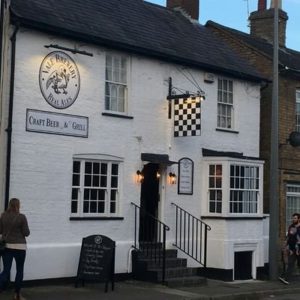
The Inns of Fenny Stratford
Going from south-east to north-west along Watling Street, the Kings Head stood where Pink Punters is now. The Saracens Head was just to the north of that, on the other side of the road. The Roebuck became the Navigation, which later became the Bridge Inn that survived till quite recently, situated just after the canal bridge. Most people will remember the Bull Inn at the entrance to Wharfside, and what was once the Fenny Stratford Brewery. The Swan is still on the crossroads, although the original inn was pulled down and rebuilt around 1900 to facilitate the building of Fenny Stratford Town Hall. On the opposite corner of Simpson Road was the Rose & Crown, until it was cleared away by 1970’s progress. The Chequers stands between residential properties on the eastern side of Watling Street, then known as the High Street. The Three Tuns was on the opposite side, a little further north. There is a long break in pubs until the Denbigh Hall Inn (also known as the Marquis of Granby) which stood just to the north of the mainline railway bridge over Watling Street. To the east, from the main crossroads in Fenny, the Red Lion appeared soon after the canal did in 1800. The White Hart once stood just beside the canal bridge going towards Simpson, on the right where modern houses now stand. West from the main crossroads, the Bull & Butcher and the Maltsters Arms still remain in Aylesbury Street. The Foundry Arms was on Victoria Road until recently too.
Further on you come into Water Eaton; this had the Plough, (now a mosque), and also the George on the Stoke Road, (now a veterinary practice). The New Inn or Halfway House was, understandably, halfway towards Bletchley, and is now the new Captain Ridley’s Shooting Party. Old Bletchley has had many other pubs too. However, there were many, many more Fenny Stratford inns in the last three centuries, which we have lost the exact locations of, such as the Hare, the Pack Horse, the Spread Eagle, and the Punch Bowl.
Previous Research
When I started this research, from the newspaper reports I could find I formed an opinion that the Chequers had once been known as the Buck & Bell, as the disappearance of one name happens at about the time of the appearance of the other, fitting nicely together. However, two previous local history researchers seemed to agree that the Chequers had once been known by the name of the Bell, (and there is one deed to prove it) but their work conflicts with each other in other places, and I found correspondence of one criticising the work of the other, which confused things further.
Edward Legg
The local historian for Fenny Stratford and Bletchley, Edward Legg (1938-2008) donated all his research work to the University of Buckingham. In a file (QTO942.593BLE) he gathered his notes on local inns, and says this:
“Chequers, formerly The Bell, built pre-1662.
Chequers, High Street, Simpson Parish. First mentioned in 1753, (formerly the Bell Inn) it is an 18th century inn remaining in much of its original buildings. An early chimney of thin brick remains visible above the roof while the open fireplace remains below. Attached to a beam above the hearth is the original Sun Insurance sign found during recent renovations and now the only one left in the town. During the 19th century the landlord had a bakery there but later in the century it had become a common lodging house from which level it only recently recovered.”
There is no information about where the “pre-1662” information comes from, and I cannot locate this anywhere else, except on an index card at the Centre for Bucks Studies, however, I have examined those deeds and they date from 1727 & 1758. He goes on to discuss another Chequers also in Simpson parish, (site unknown),and the fact that there were also two “Red Lyons” locally. These are recorded when the Bucks Alehouse Register opens in 1753, but there is no mention at that time of an inn called the Buck & Bell. This does not appear until 1773, when it is run by Richard Gardiner, although he appears earlier at an un-named inn. The Alehouse Register is at the Centre for Buckinghamshire Studies (Q/RLv 1-8)
He also adds:“Buck & Bell. Site and origin unknown, it was demolished before 1784 and its windows with other wood used by John Day for the repair of the Charity House i.e. the former Angel Inn.” That information is taken from the William Cole Diaries at the British Museum.
Legg did not have access to the archives and search engines we now do, and the Buck & Bell was certainly not demolished before 1794, as it appears in press reports up to that time.
Laurence Wulcko
The other research I have used was that of Laurence Wulcko (1901-1977) at the Centre for Bucks Studies, Aylesbury. He researched the Alehouse Register and Fire Insurance records extensively and pieced together histories of inns all over our county and further afield.
In his notes (D119/100) he states that Bradbrook’s ‘History of Fenny Stratford’, the Bell is noted to have been “mostly pulled down by 1720”, yet he writes that there is a 1754 entry in the Alehouse Register of a victuallers recognizances for Alexander Coleman, and it was the Coleman family who changed the inn’s name from Bell to Chequers, but no date for the change is given, or where this information comes from.
He lists landlords for the Buck & Bell, amongst which is Richard Gardener (1767-1776). This is corroborated by the newspaper reports of the time. The Buck & Bell must also have been on the east of Watling Street as it appears variously under Simpson of Fenny Stratford throughout the years, and an advert for it from 1794 says “The first house in the town from Dunstable and the last from Stony Stratford.” The last entry for it is 1801.
The Alehouse Register shows Richard Gardener at the Chequers for 1780-1788. Landlords quite often moved between local pubs, until brewers worked out that they often took much of the business (i.e. the regular drinkers) with them, and so began to put clauses into licensee contracts that if they left a pub, they could not take another within 50 miles or so.
The Buckinghamshire Alehouse Register
Parliament passed an Act instructing records of licenced alehouses to be kept from 1753. The books for Buckinghamshire have survived at the Centre for Bucks Studies in eight thick volumes (Q/RLv 1-8). The County was divided into Hundreds, and most of Milton Keynes falls into the Newport Hundred area. They are then listed by parish. Not every year gives the inn signs. Entries for the Chequers can be found under Fenny or Simpson. As stated, there is some doubt as to whether either of the two Chequers mentioned in 1753 relates to this building. It is more likely that the entry for Alexander Coleman at the Bell in 1754 relates more directly to the Chequers we know. My idea that the Bell may have later become the Buck and Bell and then the Chequers, is doubtful as both appear in 1783.
Bucks Register of Alehouses entries:
| Year | Parish | Landlord | Sign |
|---|---|---|---|
| 1753 | Fenny | Francis Saunders | Chequers |
| 1753 | Fenny | Thomas Parrott | Maiden Mile / Chequers |
| 1754 | Fenny | Alexander Coleman | Bell |
| 1754 | Fenny | Francis Saunders | Chequers |
| 1755 | Fenny | Francis Saunders | Not given |
| 1755 | Fenny | Alexander Coleman | Not given |
| 1756 | No entry …Until | ||
| 1767 | Fenny | Richard Gardener | Not given…until |
| 1773 | Fenny | Richard Gardener | Buck & Bell |
| 1774 | Fenny | Richard Gardener | Not given |
| 1775 | Register not kept | ||
| 1776 | Fenny | Richard Gardener | Buck & Bell |
| 1777 | No entry | ||
| 1778 | No entry | ||
| 1779 | No entry | ||
| 1780 | Fenny | Richard Gardiner | Chequers |
| 1781 | Fenny | Richard Gardener | Chequers |
| 1782 | Simpson | Richard Gardener | Chequers |
| 1783 | Fenny | Richard Gardener | No sign |
| 1783 | Fenny | William Pike | Buck & Bell |
| 1784 | Fenny | Richard Gardener | Chequers |
| 1785 | Fenny | Richard Gardener | Chequers |
| 1786 | Simpson | Richard Gardener | Chequers |
| 1787 | Fenny | Richard Gardener | Chequers |
| 1788 | Fenny | Richard Gardener | Chequers |
| 1789 | Simpson | Richard Gardener | Chequers |
| 1790 | No entry | ||
| 1791 | Simpson | John Hooton | Chequers |
| 1792 | Fenny | John Hooton | Chequers |
| 1793 | Simpson | John Hooton | Chequers |
| 1794 | Simpson | George Bodsworth | Chequers …Until |
| 1821 | Simpson | Elizabeth Foster | Chequers …Until |
| 1825 | Simpson | Henry Gaskins | Chequers |
| 1826 | Simpson | Henry Gaskins | Chequers |
| 1827 | Simpson | Henry Gaskins | Chequers |
| 1828 | Register not kept |
Early history
You need to imagine Fenny Stratford when it was a remote outpost on Watling Street, a main thoroughfare to the northwest from London. The roads were dangerous places for traffic and travellers. Not only were they rough and unmade in most places, they also provided prime opportunity to highway men or footpads to hold you up and steal everything you had about you. Fenny gained an upper hand of neighbouring towns when it was given the right to hold a market in 1269, although this was later suspended at the time of the Great Plagues that swept England, and even the main road was closed. Watling Street was turnpiked in 1707, meaning travellers had to pay to use it, and the proceeds were spent on the road. Indeed, £7000 was spent paving the road over the next two years. Water Eaton and Bletchley each had their own settlements, but Fenny had the benefit of being on the main road, which meant travellers, and travellers brought money. Inns sprang up along the road; good ones for rich travellers and cheaper ones for their carriage drivers, the carters and shepherds. In 1800, the Grand Union canal arrived and also cut through Fenny, bringing more businesses and businessmen who wanted access to the canal to import or export goods around the country. Barges were horse drawn, so stables were needed, food for the horses and the bargees. While Bletchley (firstly at Denbigh) got the mainline railway station, at least Fenny had a stop on the original Oxford – Cambridge line, now reduced to Bletchley to Bedford. So Fenny has had waves of development which all required hospitality and services for weary travellers.
Fenny Stratford did not have its own ancient church; the inhabitants once had to travel to Bletchley. There was an early chapel here, c.1460-1547, dedicated to St. Margaret and St. Katherine, but this was supressed by Henry VIII. By 1710, some non-conformists had built their own chapel, much to the disgust of local Lord of the Manor, Browne Willis, who set about buying the freehold of their land and tearing it down again! He later bought the site of the previous St. Margaret and St. Katherine chapel, and in 1724 laid the foundation stone of what would become St Martin’s. The roof was on and a bell installed by 1727.
A deed of 1841 mentions that the Chequers used to be known as the Bell. It would certainly be a suitable name for an inn so close to the church. Inns had decorative signs hanging outside as most people were illiterate at the time, and inn signs were also used by travellers to navigate by.
According to Wikipedia, the inn name Chequers is often derived from the coat of arms of a local landowner, but I am unable to find any such local arms containing a checked pattern. Bradbrook’s ‘History of Fenny Stratford’ (1911) says that other Chequers Inn’s trace their name to the De Warenne family Arms, but as far as I know, they have little connection to this area, as they were Earls of Surrey and Dukes of Norfolk. The name Chequers may also have originated in ancient Rome when a chequer board indicated that a bar also provided banking services. The checked board was used as an aid to counting and is the origin of the word exchequer. There is also a plant, the Wild Service Tree or “Chequer(s) Tree”, the fruit of which was used to flavour beer before the introduction of hops.
A small collection of deeds about the Bell at CBS gives a few clues:
1693 August 31st (BAS 194/44)
Conveyance from Thomas Kidgell(?) and wife Elizabeth to Benjamin Atkins and wife Elizabeth.
1699 August 6th (BAS 195/44)
Mortgage agreement between Benjamin Atkins, William Sympson and William Ashwell.
1716-17 January 15th (BAS 196/44)
Assignment of Mortgage between John Sympson, Elizabeth Hull and Ann Hampson.
1722 July 12th (BAS 197/44)
Assignment of Mortgage between John & Ann Norman, Elizabeth Hull, widow, and Elizabeth Tympe
1727 December 12th (BAS 441/42)
A indenture records that Elizabeth Hull was selling to Ralph Coleman “…all that cottage lately called or known by the name of the Bell Inn, lately in the occupation of James Wooding, now Alexander Coleman.” It mentions in the abutments that the road to Stony Stratford was on the southside. It also says that Mrs. Hull’s daughter had married Alexander Coleman, so she was selling to her son-in-law.
1758 February 9th (BAS 198/44)
Indenture between Ann Coleman, (now the widow of Alexander Coleman, who was buried at St. Martin’s on 10th May 1757) and Thomas Cooke of Water Eaton. The deed is a mortgage for £30 on the “…messuage where Ann Coleman doth dwell, commonly called or known by the sign of the Bell.” Ann herself was also later buried at St. Martins on 11th January 1761.
The Buck & Bell
It is a shame the Chequers cannot be tied with any certainty to the Buck & Bell, as there are several interesting newspaper reports of that house, whilst almost none that mention just a Bell Inn.
The Buck & Bell appears in the Alehouse Register by name from 1773, being run by Richard Gardener. He appears as far back as 1767, but inn signs were not recorded in that year. It gets an early mention in local papers when it is given as a location to obtain auction catalogues from, in the Northampton Mercury of 11th June 1770. No landlord’s name is given, but one does appear when the inn was mentioned again the next month in the Northampton Mercury again. 9th July 1770:
“To be Sold to the best Bidder, on Monday the 16th of this instant July, upon such terms as shall then be produced, between Three and Five o’Clock the Afternoon, at the House of Richard Gardner, known by the Sign of the Buck-and-Bell in Fenny Stratford, in the County of Bucks, A Freehold Messuage, with Yard, Barns Stables, and Home – Close thereto adjoining ‘…” The house being sold was in Stoke Hammond.
There is a mention as far away as Kent in the case of a bankrupt, who must have had connections to North Buckinghamshire. The Kentish Gazette of 26th February 1774:
“Dividends to be made. Thomas Atkins, late of Wendover in the county Bucks, Lace Merchant, Dealer and Chapman; on the 21st of March next, at twelve at noon, at the house of Richard Gardner, the Buck and Bell, in Fenny Stratford in the said county.”
In 1777, the Buck and Bell was put up for sale. Sadly, there is no report of if a sale took place (auctions were often unsuccessful) or who the new owners were. The Northampton Mercury – Monday 18th August 1777:
“To be LETT, or SOLD, and Entered on immediately, The BUCK-AND-BELL INN, in Fenny-Stratford, in the County of Bucks, (and on the Great West – Chester Road) late in the Occupation of Mr. Richard Gardener; being modern well-built House, with Kitchen, Pantries, four Parlours, seven Bed – Chambers, with Closets, five Garrets, &c. Barns, Stables, a large Garden, and Orchard well planted with Fruit-Trees, &c. For further Particulars, apply to Mr. Shaw, of Woburn, Bedfordshire; and for a View of the Premises, to Mr. Gardener, Post-Master, at Stratford aforesaid. N.B. The above Premises are convenient for a Tanner, Felmonger, Baker, or any other Business that requires a roomy, plentiful, and a pleasing Situation.”
Richard Gardner ran the Buck & Bell from 1767 to 1776, and a Richard Gardner ran the Chequers from 1780-1789. Wulcko says there is a Fire Insurance document for the Buck & Bell in 1783, issued by Royal Exchange to owner William Anstee of Luton, a draper, when the inn was occupied by William Pike and widow Gardner, “near the bridge”, so perhaps the two Richards are not the same man, but father and son?
A nice advert for it appeared in the Northampton Mercury – Saturday 5th April 1794:
“Carriers, Waggoners, and Masters of Stage Coaches. Travelling through Fenny Stratford in the County of Bucks, situated between Dunstable and Stony Stratford, 45 Miles from London, may be accommodated with Good Stabling, just fitted up in the best manner, for 30 horses, with comfortable Beds, and every Convenience for Passengers, at the Buck and Bell, Fenny Stratford, by their humble servant, William Waters, (from London) N.B. The first house in the town from Dunstable and the last from Stony Stratford.”
That is the last press reference to the Buck & Bell as an inn in Fenny or Simpson I can find, but there is this reference to just a Bell in the Oxford Journal of Saturday 31st May 1800:
“The Grand Junction Canal was in Wednesday opened for barges from the Thames at Brentford, to Fenny Stratford, in Buckinghamshire, and early in the morning a number of boats started from Tring, in Hertfordshire, at which place the canal has been completed these two years past; about one o’clock they passed through Leighton, in Bedfordshire; and a short distance before they reached Fenny Stratford the Marquis of Buckingham, accompanied by a number of friends and principal proprietors, attended by the band and a party of the Buckinghamshire Militia, met them. They then went in grand procession to Fenny Stratford, where they were received with firing of cannon belonging to the town, and other demonstrations of joy. The Marquis and the proprietors retired to the Bell Inn to dinner.”
The Bell/Chequers was a very small inn compared to some of the other Fenny hostelries, and I can’t help but think this was a typo for the Bull, which was far larger and well-respected in area, and seems far more likely. I imagine the ‘cannon belonging to the town” were the famous Fenny Poppers, still fired on special occasions today, although they have been recast since that time.
The Chequers Timeline
With all those caveats about location, name changes, landlords moving and other confusion aside, this is what can be found about the Chequers. The newspaper articles are taken from the online British Newspaper Archives, in which the first copies of the Northampton Mercury currently available are from 1770, although the paper can be traced back to 1720. [https://www.britishnewspaperarchive.co.uk/]
A Francis Saunders is recorded when the Alehouse Register opens in 1753, as running a Chequers Inn in Fenny Stratford. Yet there is also an entry in 1753 for Thomas Parrott running the “Maiden Mile / Chequers”. Saunders is still there in 1754, while Thomas Parrott and the Maiden Mile have disappeared. Saunders also appears by name in 1755, but there are no inn names given in that year.
Richard Gardener appears for 1780 to 1789, listed under Fenny Stratford or Simpson. There is a Fire Insurance record for a Richard Garner, of Fenny Stratford, Buckinghamshire, described as a “victualler” from 8th February 1786 at London Metropolitan Archives from the Royal and Sun Alliance Insurance Group. (MLA: CLC/B/192/F/001/MS11936/334/515393) This must have been during his tenure at the Chequers, but it is not mentioned by name. He insured the building “brick built, panels & tiled” for £30, his utensils and stock for £60, and his wearing apparel therein for another £10.
After no entry for it in 1790, a John Hooton then appears for 1791 to 1793, again sometimes under Simpson, and sometimes under Fenny. He had a recognizance (Guarantor) of John Bailey of Stony Stratford. A John Hooker appears for 1794, no doubt a clerical misspelling of Hooton.
George Bodsworth, is also listed from 1794 to 1820. A George and Mary Bodsworth were baptising their children at St Martin’s at this time: George (April 1796), James (November 1802), Ann (June 1806) and Richard (February 1809) and Jane (December 1811). While he was at the inn, the first newspaper articles mentioning the inn started to appear.
Northampton Mercury – Saturday 28th December 1816
There was an advance notice on December 14ththat the Newport Pagnell brewery of Baseley & Stapleton would be being sold by their assignees, unless a private buyer was found in the meantime. They had been trying to sell their business and the estate of pubs as one lot since April 1815, but no-one was buying. They had gone bankrupt by January 1816, and the administrators now put the brewery up for auction, and all the pubs separately. Ten freehold and eight leasehold properties would go with it, with further details to follow, which they duly did.
The sale consisted of the freeholds of the George at Emberton, the Rose & Crown as well as the Kings Head at Sherington, the Brewers at Castlethorpe, the Rose & Crown and the Dolphin at Newport Pagnell, the Bell at Bradwell, the Crown at Shenley, the Marquess of Granby and the Chequers at Fenny. There were also the leases for the Red Lion, the Three Tuns and the Kings Arms at Newport, the Dolphin at Stoke Hammond, the Bull at Fenny, the Crooked Billet at Stony Stratford and the Nags Head at Great Linford. The Chequers is described as: “Lot. 9 – Chequers, Fenny Stratford, with Yard, Stable Garden and Drying Ground; also Barn and Stable.”
This sale too found no buyers. There was much legal wrangling, but the High Court of Chancery instructed that the sale should take place in March 1818.
Northampton Mercury – Saturday 3rd January 1818
Pursuant to a High Court of Chancery Order in the action of Chibnall v. Baseley and Chibnall v. Marks, 11 lots were to be sold on 26th March 1818 at the Swan Inn, Newport Pagnell. By now, two years into the sale process, there are only eight pubs still listed for sale, including the Chequers at Fenny Stratford. The others must have already been sold off. The buyers are not known.
(The previous owner of the Newport brewery, Thomas Meacher, had also gone bankrupt, in 1810, but the eventual purchasers from Baseley and Stapleton had more success. They became the Rogers and Parsons brewery but having looked at the pubs in the brewery estate, they bought only three of them, and the Chequers wasn’t one of those so favoured. They carried on for 50 years before selling up in 1875.)
George Bodsworth was followed by Elizabeth Foster in 1821 and 1823. Legg’s notes say she left to become the Post Mistress for Fenny. By 1824, Legg says that Henry Gaskins had arrived, and the Alehouse Register of 1825 has him as landlord, with George Hillyer of the Plough at Wavendon standing sureties for him in a reciprocal arrangement in 1827.
Gaskins appears in the 1830 Pigot’s Directory, his name reoccurring in 1832, yet there are no press reports about him during his time in Fenny Stratford at all. Legg notes a Thomas Lowe in 1835, but there is no indication of where that name and date came from, presumably a typo for the next landlord in this news report.
Bucks Gazette – Saturday 28th October 1837
“On Thursday week the heads of two fowls belonging to Mr Loe, of the Chequers, Fenny Stratford were wrung off, and the bodies carried away.”
From this point, the advent of the census makes things much more certain. The 1841 census is the first one with individual’s names, rather than just a count of inhabitants. John Loe, aged 35, is described as a “Publican” of the High Street, Township of Fenny Stratford, Parish of Simpson, along with Mary Loe, 30, Sarah Loe, 5, and John Loe, 3, as well as William Loe, 60 (his father I expect, as relationships were not listed in the 1841 census.)
A descendant of Mr. Loe has provided some family history details to the website. John Loe died in spring 1841, and his widow Mary took the inn. https://pubshistory.com/Buckinghamshire/Bletchley/Chequers.shtml
Bedfordshire Archives holds a 20-page Abstract of Mortgage (Lease & Release) (BH407) which is dated 29-30 January 1841. In it, the Burr brothers, brewers of Dunstable, mortgage their brewery and estate of inns. Either at the Baseley & Stapleton sale of 1818 or sometime after, the Burr brothers had come into ownership of the Chequers. It is described as:
“…and also all that messuage, cottages or tenements called or known by the name or sign of the Bell Inn and formerly used as 3 tenements & lately divided into 4 cottages, but then converted into one messuage called or known by the sign of the Chequers, site and being in Fenny Stratford in the county of Bucks., and also the garden and orchard behind the same (the whole of which had been converted into and was then used as Garden ground) and the yard, stable and barn thereby adjoining and belonging the house and owned then or late of Jn. Edge on the east, the tenements then or late of W. Rogers on the west, the London road on the south, and the ground late of Dan’l. Atkins and afterwards of Lynch Conway, Gent. on the north, as the same premises were therefore in the tenure or occupation of George Bodsworth and were then in the occupation of ____ Gurney.”
So here is the confirmation that the house had been called the Bell before it was the Chequers, and there had been quite a substantial rearrangement in the structure of the building. This deed must have been found by both Walcko and Legg in their time. As discussed, there are almost no historic mentions of a Bell inn in Fenny, apart from those regarding the Buck & Bell. I can’t help but wonder if the solicitor just omitted the “Buck &” part of the name, given the change had happened so long ago, and that the Burr’s were likely to have used a solicitor in Dunstable who would not have known the history of an inn in Fenny Stratford. Gurney is not a name that appears in the Alehouse Register or news reports, but that ends in 1828, and he could have been a landlord after Gaskins and before Loe, i.e. in the period 1830-1835.
At some point, widower George Kitchener appears on the scene, and is eventually married to the widow Mary Loe in 1844, (when he was 21 and she was 33) thereby becoming landlord himself, as recorded in the Post Office Directory of 1847.
Ten years had now passed since the last and a new census was taken in 1851. Although no pub name is given, George Kitchener is there, described as a “Licenced Victualler”, now aged 28. This time, the authorities had added fields for ‘Where born?’, so we know George came from Flitton, Beds., and Mary, now 40, from Stoke Hammond. Both the late John Loe’s children are still with them, but there is also now a George Kitchener jnr. aged 5, and Edwin James, aged 1. With a pub, a bakery, and four children, they probably welcomed the additional help of their servant, Ann Lerwick, a 17-year old from “Waddon” (Whaddon) too. George Kitchener was very keen on cricket…
Bucks Herald – Saturday 19th November 1859
A long report of a court case, of King v. Kitchener, headlined “A Cricketer Bowled Out!” in the Court of the Exchequer, at Guildhall, London. King ran the Navigation Arms, at Fenny Stratford, (later rebuilt and renamed The Bridge) and Kitchener ran the Chequers. King had sued for slander, but Kitchener pleaded not guilty. Both were members of the Fenny Stratford Cricket Club, and at a meeting on 29th July, at the Chequers, King had said a certain cricket match had taken place within the last year, while Kitchener said it had not happened, and he bet 12 bottles of wine to one that it had not taken place. King went home and consulted his books and found he was correct. Someone suggested the bet should be withdrawn, but Mr King wanted his dozen bottles. Kitchener said “Oh, you cannot afford to lose anything, you have more debts now than you can pay.” King asked him to repeat that statement, which Kitchener did, while banging on a table.
Mr Clark, a painter and glazier gave a statement to the Court which matched King’s account. Mr Taylor, also a painter and glazier, gave the same statement (but only after insisting his costs be paid first, by the plaintiff!). Mr Purser, a maltster, said he was not in a condition to hear what was going on, being rather the worse for liquor, much to the Court’s amusement.
King’s solicitor said it was one of the most trumpery cases ever to come under his notice, and was only a common public house squabble. The Judge agreed and plaintiff was nonsuited.
The 1861 Census shows Kitchener as a baker and publican. Both Loe children had left home by now, but there had been the addition of another Kitchener son, Charles, who was now 9. His eldest son, George, also took up the baking trade and established a large business in the area, which was handed down to his own sons when he died in 1906.
Oxfordshire Telegraph – Wednesday 20th August 1862
A cricket match was held between Fenny Stratford and Winslow. Fenny won, with Kitchener taking 6 wickets and scored 6 runs, batting second in the order.
“Refreshments were provided in a booth on the ground by Mr. G. Kitchener, sen., of the Chequers Inn, and a dinner served between the innings, to the cricketers and their friends. After the game, an adjournment took place to the Chequers Inn, where an agreeable evening was spent.”
Croydon’s Weekly Standard – Saturday 18th April 1863
Fenny Stratford Cricket team started their season by combining with Simpson for a match against 12 members of the Phil-Harmonic Society, which included Mr. G. Kitchener. Fenny won, and the teams then went to the Chequers for “a substantial repast”.
I wonder if Kitchener sung at the inn? A local directory records Kitchener still at the inn in 1863, but the same year, a report showing a man by the name of Smith appeared.
Bedfordshire Mercury – Saturday 16th May 1863
“Bletchley. Accident – On Tuesday evening, the 5th instant, a lad named Joseph Harpur, in the employ of Mr. Smith, of the Chequers, High-street, was going up a ladder into the loft, when the ladder slipped, and Harpur fell to the ground with his right arm under him, breaking it in two places. He was at once removed to the Bedford General Infirmary.”
The 1864 Post Office Directory still has Kitchener, as does Cassey’s Directory of 1865. Perhaps Smith just rented some of the buildings at the rear of the inn for another business? Kitchener had gone by 1867.
Buckingham Express – Saturday 9th February 1867
“Permitting Drunkenness. Henry Ward, of the Chequers public-house, Simpson, was charged with permitting drunkenness and other disorderly conduct in his house on the 22nd ult. Penalty and costs 1/11s; paid.”
Brewers usually took a dim view of their landlords being convicted for events on their licensed premises so it is perhaps not surprising there is no further mention of Mr. Ward. Certainly, by the time of a Kelly’s directory of 1869, the inn was run by Thomas Underwood, who was also a cooper (a useful trade in an inn business I would have thought…) but he left in April 1870 to take another Chequers Inn, the one at Leckhampstead. So, the inn was up for rent again, but this time by different owners. At some time since 1841, ownership of the inn had transferred to the Fowler brothers, the brewers of Woburn.
Leighton Buzzard Observer & Linslade Gazette – Tuesday 15th March 1870
“Fenny Stratford, Bucks. To Be Let, the Chequers Public House, with Bar, Club, and Tap Rooms, good bakehouse and oven, yard, garden and Out buildings. Apply to H. and J. C. Fowler, the Brewery, Woburn.”
The Fowlers had a small estate of inns in the area, with the main brewery in Woburn, behind what was the Birchmoor Arms, now the Birch. I presume they found a way to keep inn open somehow, and keep its license current, but the next report is also an advert for a new landlord, from the end of the same year:
Leighton Buzzard Observer and Linslade Gazette – Tuesday 20th December 1870
“Fenny Stratford, Bucks. To Be Let, the Chequers Public House, with good bakehouse and flour lofts attached, yard, garden and stabling. Free for spirits. Apply to H. and J. C. Fowler, the Brewery, Woburn.”
I cannot find any trace of the following Mr. Dinnell, apart from his leaving the Chequers. Perhaps he was an employee of the brewery, brought in to manage the inn between tenants?
Croydon’s Weekly Standard – Saturday 11th February 1871
Licence Transfers: Chequers Fenny Stratford from W. Dinnell to James Rogers.
…but Rogers came with debts he had already accrued in his previous career as a farmer. Perhaps he only took the job as it meant having a place to live and a small income, but the income turned out to be even smaller than he expected:
Croydon’s Weekly Standard – Saturday 18th March 1871
Report of a court case, of Hives & Sons v. James Rogers. Hives& Sons were coal & corn merchants of Newport Pagnell, and Rogers owed them £29. He had been a farmer at Turvey and Charlton before moving to the Chequers. He had some land that was for sale, but once it sold, the income was only going to cover the mortgage he had taken on it. He said that the Chequers was only selling four or five gallons of ale a week, for which he received just 4-pence per gallon for selling, and “…in fact he intended to get out of the house as soon as he could…” The judge suggested waiting for the land to sell and seeing how much Rogers could then pay. Case adjourned.
Croydon’s Weekly Standard – Saturday 22nd April 1871
In an update to the case above, Rogers said he had now closed the Chequers and was quite destitute. The summons was therefore dismissed.
It is useful that another census took place in 1871. James Rogers is shown at the inn as an Innkeeper, no house name given. He was 65, and born in Turvey, while his wife Elizabeth, 66, just says “London”. They had a George Skevington with them, listed as their grandson, just a year old, and a servant, Harriett Crawley, 43. There was another James Rogers, three doors away, working as a blacksmith. That must have caused some confusion!
Whether there was a full-time replacement landlord for Rogers, or if the brewery just put someone in temporarily to keep it open is not recorded, but by the next year, Fowler (now singular, as his brother had left the business) of Woburn was advertising it again.
Bedfordshire Times & Independent – Tuesday 22nd October 1872
“Free Spirit House – To Be Let, with immediate possession, the Chequers Public-house, at Fenny Stratford, with Bar, Bar Parlour, Tap-room, with Bakehouse, Good Lofts, and Stabling attached. Apply Henry Fowler, The Brewery, Woburn.”
In 1872, a survey of all licensed premises in Buckinghamshire was ordered, including the details of landlord and owner. The Chequers is listed under Simpson parish. It says it had been open for longer than 50 years, as was now run by Jonathan Cashmere, still owned by Henry Fowler, of Woburn. However, before January 1874, it had been taken on by George Scott. It appears he may have come from the White Hart, down the Simpson Road, as a landlord of the same name was there at the time of the 1872 survey, and that house was also leased to Fowlers of Woburn. Other pubs that Fowler’s Brewery ran in 1872 were: the Red Lion at Newton Longville, the Plough at Shenley Church End, the Prince of Wales at Edlesborough, the Jolly Dogs at Stewkley (leased), the Spinning Wheel at Great Brickhill, the Wheatsheaf at Bow Brickhill, and the George and Dragon as well as the Kings Arms in Little Brickhill, and the George in Bletchley. (By the 1881 census, the White Hart was run by a William Scott, a 69-year-old widow. I wonder if this could have been George’s father or brother?)
Croydon’s Weekly Standard – Saturday 24th January 1874
“For Sale – A Capital Horse, sound, and in good condition. Also a Four-wheel Bus, Cart and Harness, with or without carrying business. For particulars, &c., apply G. Scott, Chequers Inn, Fenny Stratford. Satisfactory reasons will be given for relinquishing the business.”
Northampton Mercury – Saturday 7th February 1874
“Fenny Stratford – Thomas Ayres, charged with stealing a pipe and case, value 2s. 6., the property of George Scott, “The Chequers,” Fenny Stratford, on the 2nd February. 21 days hard labour.”
We are fortunate that photographs had begun to be taken of convicted felons, in order to prevent multiple aliases being used, and thereby avoiding harsher sentences for repeated convictions. Thanks to the work of the Centre for Buckinghamshire Studies, we have an image of Thomas Ayres from the County gaol receiving books. His prison record shows he was a bricklayer, born in Wootton, and living in Woburn Sands. He was 35 years of age.
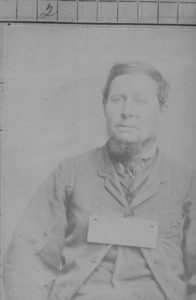
In July 1880, Henry Fowler tried to sell up. The Brewery at Woburn and 28 freehold and leased premises were advertised to sell by auction “in early August”. The Chequers is not mentioned by name in the advert, but Fenny Stratford is given as a location for one or more of the inns included in the sale. However, when August came, the Auctioneer advertised that the sale had been postponed. Fowler tried again in March the next year.
Leighton Buzzard Observer & Linslade Gazette – Tuesday 8th March 1881
There was an auction of the estate of Fowler’s brewery, Woburn. From the auction sale particulars of the Woburn brewery and tied houses, to be sold by Thomas, Peyer & Miles, at The Swan Hotel, Bedford, on 26th February 1881.
“[The auctioneer] next put up the following twenty-four freehold houses – Malt House, Woburn, and the Birchmoor Arms; King’s Arms, Little Brickhill; Spinning Wheel, Great Brickhill; Wheatsheaf, Bow Brickhill; Chequers, Fenny Stratford; George, Water Eaton; Red Lion, Newton Longville; Plough, Shenley; Stag, Leighton Buzzard; Bell Inn, Hockliffe; Victoria, Dunstable; Fountain, Luton (Wellington Street): Marquis of Bute, Luton (Alma Street); Bell, Totternhoe; Fountain, Eaton Bray; Prince of Wales, Eddlesborough; Red Lion, Eversholt; Nag’s Head, Westoning; Drovers’ Arms, Steppingley; Anchor, Aspley Guise; May Pole, Aspley Guise; Queen’s Head, Ampthill; Carpenter’s Arms, Cranfield; and Bricklayers’ Arms, Bedford (St. John Street)…These houses realised collectively the sum of £14,560. One of them (the Fountain, Luton), let at only £15 a year, sold for £1,500, being 100 years’ purchase on the rental. The collective rentals amounted to £285 year.”
Charles Wells, the brewers of Bedford, bought nine of the lots, for a total of £4,480, however, they did not buy lot no.5, which was listed as:
“Chequers Public House, Fenny Stratford – parlour, tap room, cellar, pantry and kitchen with loft over, club room and bedroom, two first floor bedrooms, bakehouse at rear; – detached cart lodge, stable, wood barn and piggery with loft over whole; – yard and garden with right of way to adjoining property; – let to George Scott at £12 per annum.”
Some idea of the size of the brewery can be gauged by the sale two months later of all the equipment from it. Whoever had bought it had decided they wanted the Birchmoor just as a pub and must have had no use for the brewery premises at the back. They didn’t even want the beer that had already been brewed!
Leighton Buzzard Observer & Linslade Gazette – Tuesday 10th May 1881
“Brewing Plant, Casks, Horses, Harness, Drays, Beer, Hops, and Miscellaneous Effects appertaining to the brewery, Woburn, Beds. Messrs. Alfred Thomas, Peyer & Miles will sell by Auction, on the premises, on Wednesday, the 18th of May, 1881, at Eleven o’clock precisely, The Plant, Utensils, and Rolling stock of the above Brewery, Consisting of a 20-barrel open copper, excellent horizontal steam engine with boiler and machinery, Baudelot’s refrigerator, mash tun, working tuns and other backs, set of unions, five-store vats, pipes, cocks, and other metal, about 800 casks from hogsheads to firkins, three horses, harness, drays, and carts, a quantity of season-brewed pale ale, new hops, stack of hay, sundry stillions, and loose effects, of which catalogue may be had on the premises, and of the Auctioneers, 2 Adelaide Place, London Bridge, E.C.”
What had happened to Henry Fowler to cause this fire-sale? A clue is that the March 1880 sale was subject to reserve bidding, fixed by the Masters in Lunacy. In November 1881, a distress warrant was issued against him for non-payment of poor and highway rates, and it says he was now an inmate at a lunatic asylum.
1881 saw another census, and by now, although entered as “Chequers Inn”, Scott had overseen the transition of the inn to being a common lodging house, a far cry the time of providing “substantial repasts” to the Fenny Stratford Cricket team 20 years before. Somehow, Scott had managed to squeeze himself (43, born in Great Brickhill), his wife, (43, born Stradbrook, Suffolk) a niece (Ellen Boast, 14, working as a domestic servant, born Deptford) a 30-year old male servant called (what looks very much like) James James, and 10 lodgers and one ‘visitor’ into the building! The lodgers are a mixture of labourers and other trades including travelling salesmen, a watchmaker and two grooms. The only female is the ‘visitor’, listed as a brush maker. This would have been accommodation at the lower end of the scale and was a place that the local constables could bring any vagrants or tramps found wandering in the parish.
There was a general tightening of laws around drinking at this time. More and more court cases of assaults, thefts and other drunken crime meant inns operating outside their licence conditions were likely to be quickly targeted by police, who would use the evidence of convictions during the past year to raise objections at the annual licensing sessions.
Croydon’s Weekly Standard – Saturday 26th March 1881
“George Scott was charged with keeping open his house, the Chequers Inn, Sympson, on Sunday, the 13th of March, during prohibited hours. Police-constable Alfred Clifford deposed to going to the defendant’s premises about half-past ten o’clock on Sunday, the 13th inst., in company with police-constable Churchill, where he saw John Rollins, who said he had just come in for a drive with John Scott. Police-constable John Churchill corroborated the statement of Clifford. Defendant deposed he was hired by Rollins to drive to Old Stratford, from which place he started home at about nine o’clock. George Price deposed that he lived at the Falcon Inn, Old Stratford, said that Scott called at his house in company with James Rollins, and they left about half-past nine in the evening. The case was dismissed. John Rollins was charged with being on licensed premises, the Chequers Inn, on Sunday, the 13th last. The summons was withdrawn.”
Perhaps Rollins had been invited in for a nightcap after dropping Scott at home!
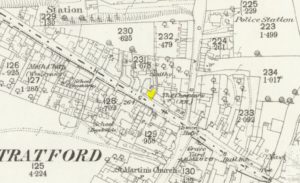
Northampton Mercury – Saturday 3rd November 1883
“James Horton, relieving officer was charged with being found on licensed premises, viz. The Chequers Inn, Simpson, after closing time, viz., at 16 minutes past 11 o’clock on the 12th of October. The charge was supported by Police-sergeant Joseph Hinton. Mr. Bull, of Newport Pagnell, who appeared for the defendant, admitted that he was in the house at the time in question, but not in contravention of the Act. In the course of his duties he had to remove a corpse from the Northampton Infirmary to Fenny Stratford, and engaged a man named Scott to do so. He went to the house to see Scott on the matter. The case was dismissed.”
The police attempting to prosecute a public servant for entering licenced premises to speak to the landlord about removing a body from a hospital to a graveyard would not have impressed the judges.
Croydon’s Weekly Standard – Saturday 4th August 1888
“Annie Williams, a tramp, was charged with damaging property belonging to George Scott, of the Chequers Inn, Fenny Stratford, on the 31st of July. Prosecutor said that the defendant had been lodging with him about a week, and had behaved very well during that time, but on the night of the 31st she came home very drunk and he advised her to go to bed. When she got upstairs she took the wash-hand basin and threw it out of the window. Both prosecutor and the husband of defendant tried to quiet her, but they could not succeed. Defendant did not have any drink in his house. Superintendent Hall said the parties were not married, and the man who had travelled with her had gone in the direction of Winslow. Defendant was fined 5s. and 7s. 4d. costs, and 2s. 6d. damage, or fourteen days.”
The Brewery History Society believes that the Aylesbury Brewery Company took ownership of the Chequers in about 1889, but I have not confirmed this date.
The next census came in 1891. Scott, now listed as “Publican and General Dealer”, his wife, their niece (entered as Nellie now, and described as “Waitress in the house”) were still there, this time with 12 lodgers. There are several couples and one widow, as well as tradesmen.
Buckingham Advertiser & Free Press – Saturday 9th December 1893
“George Scott, The Chequers, Fenny Stratford, was summoned by the Excise for keeping a dog without a license. Mr. Harmer, supervisor, Linslade, appeared for the Authorities, and stated the facts of the case. He stated that the dog had been lent for use, but not answering, it had been returned, and Scott had since destroyed. He only applied for a nominal penalty. Fined 1/-, and 9/6 costs. Paid.”
I expect he paid promptly, as the alternative, according to the Fenny Petty Sessions records, was 7 days in prison!
On 23rd April 1896, there was an Indenture made regarding the ownership of the Aylesbury Brewery Company (ABC). All their estate of pubs was listed, and at that time it already included the Chequers. “All that messuage or tenement situated and being at Fenny Stratford in the County of Buckingham now used as a Public House and known by the sign of the “Chequers” with the cart lodge stable Loft stable yard and garden adjoining and belonging now in the occupation of George Scott.”
Buckingham Advertiser & Free Press – Saturday 29th May 1897
“Fenny Stratford Petty Sessions. Thursday, May 27th, Before Capt. Levi, W. R. Rowland, Esq., J. Baisley. Esq., and B. T, Fountaine, Esq.
Drunkenness. Arthur Walduck was summoned for being drunk on the public highway at Fenny Stratford, on the 2nd inst. Defendant denied the charge. Witnesses were called who supported the evidence of the police. Mrs. Walduck was called by defendant, and she emphatically denied the charge. He had had a dispute about money matters, about his change. He had been in the Chequer’s Inn, and asked for his change, over which the dispute arose. Mrs. Scott, landlady of the Chequers Inn, was called, and deposed that defendant was drunk and quarrelsome. Defendant was fined 2/6, and 19/- costs.”
How Mrs. Scott got away with not then being charged for permitting drunkenness is not recorded.
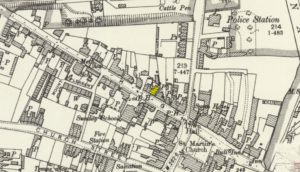
Register of Death: George Scott died in the 4th quarter of 1898. Aged 59.
An ABC Brewery Estate book survives at the Centre for Bucks Studies. (D 254/1/4/5) Every year from 1901, they valued all their premises. This was probably done for tax reasons, so they had a good motive for keeping the valuations artificially low, but the Chequers opens at £400 in their listing, and remains so right up to 1935 when the book ends. By comparison, the nearby Denbigh Hall Inn, which did not even have running water connected, was valued at £650!
For the 1901 census, widow Ellen Scott had taken over the house. Described as ‘Publican and lodging house keeper’, she had the 53-year old Arthur Derreck and 13-year old Mary Cox to help her with the 17 lodgers they had. Four are listed as ‘Pedler – Hawkers’ and one is a street musician. Ellen Scott continued for two more years, before passing away herself.
Bedfordshire Times & Independent – Friday 23rd January 1903
“The death is announced of Mrs Scott, widow of the late George Scott of the Chequers Arms, High-street. The Chequers is one the oldest the Fenny Stratford inns, and in former days was a much frequented house. Mr. Scott died some years ago, since when his widow has been carrying on the business until her death last week, after a lengthened illness, at the age of 62.”
Northampton Mercury – Friday 13th February 1903
“The licence of the Chequers Inn, High Street, Fenny Stratford, was transferred from the late Ellen Scott to J. Thurlow.”
Watford Observer – Saturday 28th March 1903
“Petty Sessions. Saturday. Before Mr. James Herbert and Mr. D. G. Patterson. Drunk and Refusing to Quit. James Sear, a trump, who stated that came from Fenny Stratford, was charged with being drunk and refusing quit the Chequers public-house. Harry Dwight, landlord of the Chequers public house, said the prisoner come into his house on Thursday afternoon, and as he was drunk witness refused to serve him. He asked him to leave the house, and as he refused witness went for the policeman. When he returned prisoner had gone. Prisoner entered the house again on Friday afternoon, and Mrs. Dwight, not noticing he was the worse for drink, served him. As soon as witness returned he took the beer from him, gave him his two-pence back, and told him to leave the premises. He refused to leave, and he had to call in a policeman to eject him. Police-constable Medley stated that after he ejected the prisoner from the Chequers, he refused to go away, so he arrested him. With that the prisoner became very violent, and struck him with a bundle he had in his hand. With some assistance witness eventually got the prisoner on a barrow, and conveyed him to the Police Station. Prisoner made of use of excessively bad language. Inspector Trevener proved that the prisoner was convicted at Chesham only a short time ago. Prisoner was fined 30s., and costs 3s. 6d., and being unable pay, was sent to the house of correction for one month.”
The names of Mr & Mrs Harry Dwight are strange, as the inn continued to be run by Mr. Thurlow, and then his widow, until 1906. Had someone got their facts wrong? There did just happen to be a Police Constable Dwight in Fenny around this time.
Croydon’s Weekly Standard – Saturday 17th June 1905
“Fenny Stratford. Dr. Nicholson reported a case of small-pox at the Chequers Inn. The man and his wife had been removed to the Isolation Hospital, at Wadden. The wife had since developed the disease. Mr. Chadwick said that all the “contacts” at the Chequers Inn had been “interned.” Col. Giles said the man and his wife came there from Newport Pagnell. The disease showed itself four days after their arrival, which meant that it had undoubtedly been contracted to Newport Pagnell.”
Buckingham Advertiser & Free Press – Saturday 17th June 1905
“Dr. Nicholson (Medical Officer of Health) reported case of smallpox which had broken out on a tramp lodging at the Chequers lnn. The case and his wife had been removed to the Woolstone Isolation Hospital. The wife had since developed the disease. The Chequers Inn has been quarantined, with all the people in it. The Surveyor reported that the cost of quarantining the Chequers Inn, with seven inmates, and including beer and tobacco, had been some £6 per week. There was a man outside the house who removed everything after disinfecting it.”
Bedfordshire Times & Independent – Friday 23rd June 1905
“The quarantine placed on the Chequers’ Inn. High-street, where the case of smallpox, imported from Newport Pagnell broke out some three weeks ago, was removed on Saturday and the interned residents released. There has been no further case in the district, except that of the wife of the man who first developed it. She was removed with him to the Isolation Hospital at Woolstone and developed the disease two days later.”
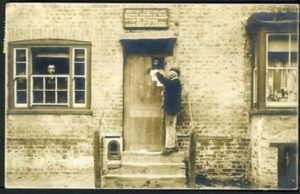
Buckingham Advertiser & Free Press – Saturday 1st July 1905
“The Aylesbury Brewery Co., had consented to do all necessary work in connection with disinfecting the Chequers Inn.”
The initial symptoms for Smallpox are similar to other viral diseases such as influenza and the common cold. It is extremely contagious, and the other occupants of the inn must have been terrified. Thankfully, the infected couple both later recovered. Having escaped this disease, Henry Thurlow must have been thankful, but less than a year later, he passed away.
Register of Death: Henry Thurlow died in the 3rd quarter of 1906, aged 41.
Northampton Mercury – Friday 19th October 1906
“Divisional Petty Sessions: Chequers’ Inn, High Street, Fenny Stratford (parish of Sympson) to Mrs Thurlow, widow of the late landlord.”
…but she didn’t stay running the inn by herself for long, as by a year later, the Hinson’s had taken over.
Northampton Mercury – Friday 1st November 1907
Charlotte Hinson, wife of Walter Hinson of the Chequers Inn, is mentioned at the inquest into a man found drowned in the canal. He had been staying at the Chequers.
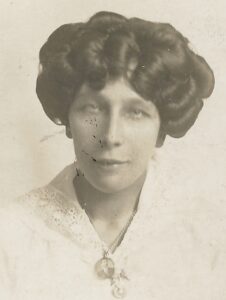
The type of customers the Chequers was taking is perhaps illustrated by the piece below. Vagrants could obtain a ticket from the parish officer entitling them to place to sleep. These were the days before the national social security acts. However, if you asked for help and were then found to have some money of your own, the penalties were harsh.
Northampton Mercury – Friday 11th September 1908
“Fenny Stratford. Not Destitute. At the Petty Sessions on Saturday (before Col. P. B. Giles). Aaron Charles Watkinson. said to come from West Ham, was brought up in custody charged with having obtained a relief ticket from Mr. Moss, relieving officer, by fraudulent and false statements, Tuesday evening. Mr. Moss said that the prisoner having come to him and pleaded destitution, gave a ticket entitling him to a night’s lodging. He was afterwards found to in possession of 8½d. P.S. Dibben said that on Tuesday night the prisoner applied to the police and was sent to Mr. Moss, threatening to commit some act of violence in order to be locked up if not relieved. Witness went to the Chequers Arms, and when prisoner went there from Mr. Moss he presented a relief ticket. He immediately demanded a “pint,” and offered to pay for it. He was searched and arrested. He was committed to Northampton Gaol for seven days’ hard labour.”
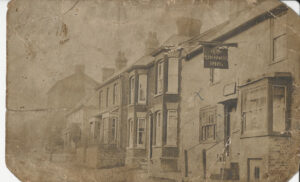
1911 is presently the last available census. Walter Hinson, 49, from Paddington, his wife Charlotte, 48, their daughter Lottie Bowler, 20, and her daughter Phyllis, just 6 months old, were in the Chequers with 14 boarders, including two noted as vagrants. There were ten rooms at the inn, including the kitchen.
Northampton Mercury – Friday 22nd September 1911
Jack Silver, described as a 16-year old tramp, stole a chicken, the property of Walter Hinson, of the “Chequers Arms lodging house”. He was given 14 days hard labour.
Register of a death: Walter Hinson died 4th quarter of 1912, aged 50. The license was transferred to his widow, as noted by the Bucks Advertiser on 18th January, 1913. Yet again, the landlord had passed away at a relatively young age, and his wife was left in charge of the inn. The next, and last report on her, finds her in trouble in the middle of the First World War.
Bucks Herald – Saturday 21st August 1915
“Fenny Stratford Petty Sessions. Charlotte Hinson, widow, licensee of the Chequers Inn, High Street, was summoned for failing to register two Italians who had slept on her premises, as required by the Aliens Registration Order. Inspector Callaway stated the facts of the case, and Mr. Allinson (Stony Stratford) who appeared for the defendant, submitted that it was a case in which justice would be met by binding his client over. Defendant was fined 10s. and bound over to comply with regulations.”
According to other local papers, on July 29th, Inspector Callaway had called at about 8p.m. to ask if her Alien Registration Form was correct. Saying yes, she then gave him a cardboard box containing a large number of registry forms, and on examining these he found two relating to Italians. He then asked if she had the alien form filled up, to which she replied “I have the form you gave me.” She then produced a specimen copy, but since no entry had been made, Inspector Callaway asked why and was told, “I do not understand it; I cannot see very well.” Yet as was pointed out, Inspector Callaway had called several times to leave and explain the specimen forms. As for the two Italians, she said she had known the men for many years, and even the police did not bother with them. Nevertheless, the gravity with which the authorities viewed such non-compliance was reflected in the potential fine of £100, or six months in prison, without the option of a fine, but since for many years she had kept a respectable house, no charge was brought. However, should this happen again action would be taken, and in conclusion she was fined 10s, and bound over to comply with the rules.
There is quite a long gap until the next report, which would threaten the very existence of the inn.
Bucks Herald – Saturday 24th May 1924
At the meeting of the Bucks Licensing Committee at Aylesbury, under chairman Sir Denham Warmington, preliminary consideration was given to reports from the various local renewal authorities to refer the Blacksmith’s Arms, Turville; the Havelock Arms, Slough; the Steam Engine, High Wycombe; and the Chequers at Simpson to the Compensation Authority in order that they have their licence renewals refused, then be closed down, and the owners paid out.
Grave news indeed. Once the Licensing Committee decided you could not have a license, a public house was usually doomed. It would take a united effort by all concerned parties to persuade them otherwise. A nationwide drive was underway to close the smaller, lower class establishments. Many returning soldiers from WW1, who had found little or no employment, had turned to cheap beerhouses and as a result alcoholism and crime had escalated. The Authorities tried to deal with the causes rather than the effects.
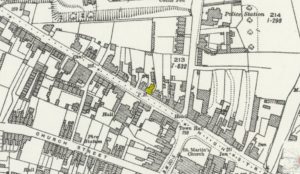
Bucks Herald – Saturday 21st June 1924
The Chequers Inn, Simpson. Mr. E. C. Fortescue, of Banbury, applied for renewal of the licence of the Chequers Inn, Simpson, the property of the Aylesbury Brewery Company, tenanted by Charlotte Hinson. Mr. P. Holborn. of Woburn, opposed the application. He said that within a radius of 250 yards there were seven fully licensed houses and one other beerhouse. The nearest licensed house to the Chequers was about 100 feet away, the second nearest about 150 feet away, and the third nearest about another 190 feet distant.
Supt. Calloway said he inspected the house in February last and found it in a dilapidated condition. He again inspected it that morning and it had now been painted, papered, and cleaned. It compared unfavourably with the other licensed houses in the way of accommodation and trade. At the beginning of 1923 he took three homeless ex-service men to the Inn for lodging and Mrs. Hinson was unable to accommodate them. On another occasion she could not provide for two unemployed, who were walking to London, with a meal. In cross-examination Mr. Fortescue put it to witness that neither the Swan nor the Bull could be considered as suitable alternatives to The Chequers as both had hotel trade. Witness did not agree with this. He agreed that there was not another house in the vicinity which accommodated the same class of lodgers. If the house was closed they could go to Newport Pagnell and many of an undesirable type would not come to the district. Witness also stated that there was one licensed house to every 159 men, women and children in the area.
The licensee said she had no other means than the inn of earning a livelihood. Her customers were of the working class, resident and casual. In the last twelve months she had had between 80 and 90 casual lodgers besides six or seven who stayed permanently.
Mr. Frank Higgens, managing director of Aylesbury Brewery Co., said they had owned the house for 30 or 40 years. It was their only house in the district and they were anxious to retain it. The average trade during the past three years was 79 2/3 barrels (not including bottled beers) and 63½ gallons of spirits, which was a very fair trade. The tenant would be getting a profit of about £3 a week exclusive of cider, tobacco and mineral waters, etc. The house should have been repaired two years ago but they were unable to get the work undertaken. Since then they had spent £122 and it was in every way suitable for the class of trade it did.
John Head said lived opposite the house and used it frequently. He produced a petition in favour of the retention signed over 250 people. Others who spoke in favour of the licence being renewed were Jesse Dumbledon, Joseph Sawyer, Frederick John Vickers, George Marston and Ernest Jacob.
William Marsh, relieving officer, of Fenny Stratford, said he had from time to time taken people there for lodging. If he could not get them in at The Chequers they would have to the Institution at Newport Pagnell. There was no other licensed house which catered for that class of customer. Mr. Fortescue also handed to the justices a testimonial to Mrs. Hinson signed by 28 total abstainers and tradespeople of Fenny Stratford.
The Chairman said it was the duty of those who appeared for the closing to show that the licence was redundant and not necessary for the needs of the neighbourhood. Having heard the evidence, especially that given on behalf of the owners, they had come to the conclusion that the house fulfilled very useful function of providing lodging for tramps and was really required for the class of trade it did. The application for renewal was granted.
At the same meeting, they decided to close the Blacksmith’s Arms, Turville, and the Havelock Arms, Slough; but keep open the Steam Engine, High Wycombe. However, one of the witnesses thought he had be misrepresented by the Bucks Herald, and had a letter published the next week:
Bucks Herald – Saturday 28th June 1924
Dear Sir, – In reference to your report re “Chequers,” Simpson in your last issue of 21st June, I should be glad if you would publish this letter in your next issue, in order to correct a statement I am supposed to have made in my evidence. What I said was, “It is the only house in that district of that particular class, that is a lodging-house.” You will see in your report, “It is the only house that my Company have in the district.” Thanking you for inserting this explanation. Yours faithfully, Frank Higgens, Walton Brewery, Aylesbury.
Bedfordshire Times & Independent – Friday 3rd February 1928
James William Roberts is mentioned as landlord of the Chequers Inn, Fenny Stratford at the inquest into the death of George Holdom, who committed suicide on the mainline railway. George was from the Bletchley brewing family, although he had spent time in Argentina as a rancher. He had returned home, and due to his excessive drinking, had been staying at the Chequers for six months. The landlord’s wife, Agnes Roberts, is mentioned in another report in the Bedfordshire Times on Friday 2nd November 1928, when a tramp tried to obtain £1 from her by using a faked letter.
George Hillier is shown as landlord in the 1931 Kellys Directory but he had gone by 1933. He died, aged 79, in 1946, and the local paper reported he had spent several years in the Metropolitan Police, mainly in the West End. A native of Wiltshire, he had come to Bletchley four years after retiring in 1920 and ran the Chequers inn for some four years.
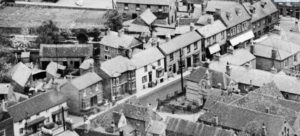
Buckingham Advertiser & Free Press – Saturday 11th February 1933
A “Mr Pay of the Chequers Inn” is mentioned in a grocer’s licence application objection.
The next mention of the Chequers is in the Bucks Herald of Friday 26th January 1934 and is the sad tale of the death of Frederick William Alcock, aged 47. He had been the licensee of the Rose & Crown in Fenny but had recently given it up. His wife had left him due to his drinking, and he had been living at the Chequers for the last 6 months, where he now owed the landlord 36s. He was last seen alive in the Bull & Butcher one evening but was found the next morning at the Bletchley Road entrance to the Recreation Ground. He had taken his own life with prussic acid poison. Mr Pay was called as a witness at the inquest, which decided on “Suicide whilst temporarily insane”.
Edward Samuel Pay left in August 1936, according to Legg. He was replaced by Charles Edward Scott, but he only stayed till the following April, 1937, when a Walter Charles Clifton took over.
Buckingham Advertiser & Free Press – Saturday 15th April 1939
“Mr. Ernest Walter Adnitt, the eldest son of Mr. and Mrs. E. Adnitt. of Northampton, and Miss Vera Joan Clifton, the only daughter of Mr. and Mrs. C. Clifton, The Chequers,” High Street, Fenny Stratford, were married in St. Martin’s Church on Monday.”
The same month, the Bucks Herald ran a piece on the news that licensed premises and other large businesses in Bletchley had had their rates increased, some by more than 100%! The Chequers went up from £18 to £35.
Northampton Chronicle & Echo – Tuesday 25th April 1950
“DEATHS. CLIFTON. April 24. Chequers Inn. Bletchley. Ethel. loving sister of Ralph Tonsley and Mabel. 1. William-street.”
In 1952, Jim & Phyllis Dudley took it on. They stayed for seven years.
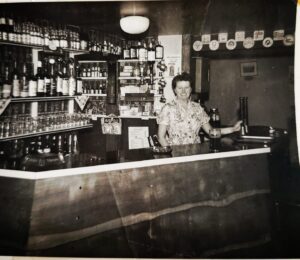
It was reported in the North Bucks Times on 12th November 1959 that Mr. C. Coles was leaving after having been at the Chequers for 15 months. He was a toolmaker at Wolverton Works and was moving in with his wife’s mother at no. 6 Napier Street, until a bungalow had been completed. Mr. G. H. Surridge had moved in last Thursday. He was 49, with a wife and two daughters and came from Bedford. Although it was his first public house license, his father had had pubs at Cotton End and Cardington. He had previously worked on the railways for 34 years.
Some records of 1960’s licence applications have survived at Bedford Archives (Z1105/1). Landlord James William Frederick Chamberlain completed his application for the Chequers in May 1960 and described the licensed part of the premises as: “No.1: On the ground floor, a Bar entered by a door on the right of the passage. No.2: Saloon Bar on the left, entrance directly opposite the front door. No.3: A cellar in the basement with access by a trapdoor behind the servery in no.1 bar and by a doorway in High Street. All rooms to be used for the purpose of storing and selling by retail Beer, Spirits and Wine for consumption on or off the premises.”
Jim ran the pub with his wife Gwen, who are both still remembered fondly in Fenny Stratford. They had two sons, Keith and John.
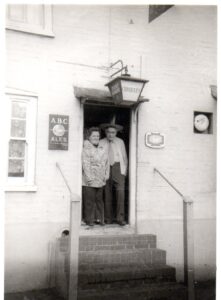
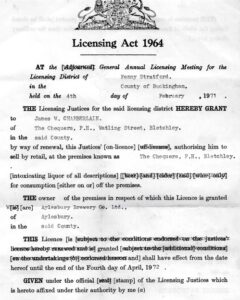
The next major event for the Chequers concerned the whole area of Fenny Stratford. A new city was coming to Buckinghamshire, when it was decided to build Milton Keynes, in which Fenny would be a part. Eventually this led to rerouting the A5 away from Fenny Stratford, via the A5(D) (not that much traffic was stopping as it had done in the coach and horse days anyway). The entire area around the crossroads was remodelled, with all the buildings on the north-west side of the road demolished, as well as the Rose & Crown on the Simpson Road corner facing the Swan, but someone had the foresight to get Listed status for the Chequers in September 1975:
“High Street 1.5135 (North Side) Fenny Stratford. The Chequers Public House SP 8834 2/36 Grade II 2. Early recasing of C17 building. 2 storeys painted brick. Gable end slate roof, gutter cornice. Raised on stucco plinth and cellar. 2 windows, flush framed glazing bar sashes, tripartite to left hand on ground floor and small rectangular, pent-roof, bay window with cellar hatch to face, on right hand. Panelled and glazed door with bracketed cornice hood. 4 steps up.” The entry was later amended to read “WATLING STREET (North Side) FENNY STRATFORD No. 48.”, after the local council officially changed the street name.
Fortunately, the Chequers was far enough away from the crossroads not to be affected by all the modernisation of Fenny Stratford, but the new city planners did come knocking about the land to the rear…
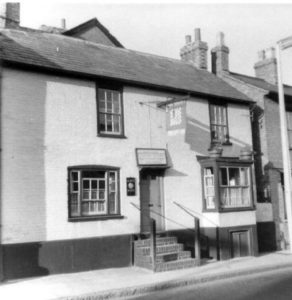
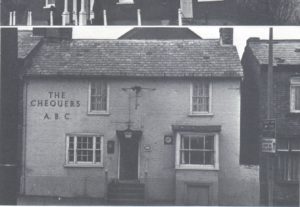
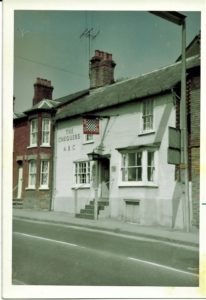
On 3rd July 1978 the Milton Keynes Development Corporation bought the rear part of the Chequers garden land from ABC for £250 and did the same to all the other houses in that row, so they could build a road to access a new housing development called Bristow Close (named after an early owner of the Rose & Crown) at the rear of the pub. Originally, the Chequers’ land went as far back as the privies that still stand in the rear gardens of the terrace houses that front Simpson Road.
For 12 years from 1976, it was run by Paddy & Molly Curry, and then from 1988 by relatives of theirs,
Hughie and Colleen Hone.
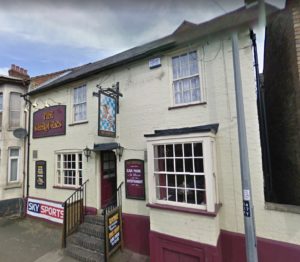
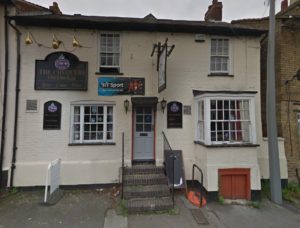
Milton Keynes Council has a listing online with all local licensee details from 2015, showing an Anthony O’Neil as landlord.
Maureen Sadler had it c.2002-c.2006, who converted the rooms upstairs to a bed and breakfast.
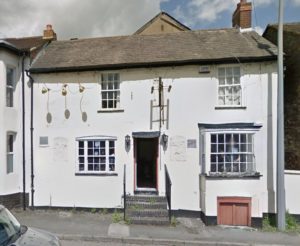
Once the refurbishment was complete, the Chequers was reopened with Tim as landlord.
Landlords & Owners
1753-1755 Francis Saunders
1780-1789 Richard Gardener (Garner, Gardiner)
1791-1793 John Hooton
1794-1820 George Bodsworth (1816 Basely & Stapleton of Newport Pagnell sell)
1821-1824 Elizabeth Foster
1825-1830 Henry Gaskins
1835 Thomas Lowe
1837-1841 John Loe (1841 Burr brothers, of Dunstable – mortgage)
1841-1844 Mary Loe
1844-1863 George Kitchener
1863 Mr Smith
1867 Henry Ward
1869 Thomas Underwood (and cooper)
1871 W. Dinnell (By 1870, owned by Fowlers of Woburn.)
1871 James Rogers
1872 Jonathan Cashmere
1874-1898 George Scott (1881 Fowler sells, ABC were owners by 1896.)
1898-1903 Ellen Scott
1903-1906 J (Henry) Thurlow
1903 Harry Dwight, landlord??
1906 Mrs Thurlow
1907-1912 Walter Hinson
1912-1924 Charlotte Hinson
1928 James William Roberts
1931 George Hillier
1933-1936 Edward Samuel Pay
1936-1937 Charles Edward Scott
1937-1939 Walter Charles Clifton
1952-1959 Jim & Phyllis Dudley
1959 Cecil Coles
1959 G. Surridge
1960 James William Frederick Chamberlain
1976-1988 Paddy & Molly Curry
1988 Hughie & Colleen Hone
c.2002-c.2006 Maureen Sadler
2015 Anthony O’Neil
Page last updated July 2022.
